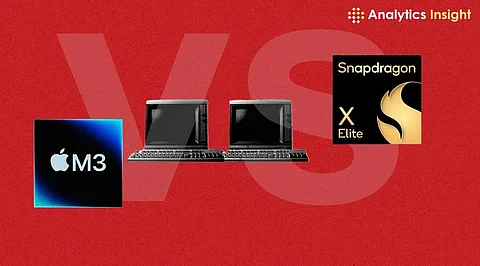

The Qualcomm Snapdragon Gen 4 and the Apple M3 Chip have brought out a fierce struggle between the two giants, Qualcomm and Apple. Together with advancements in AI capability, these new-generation CPUs will bring some important gains in computation and energy efficiency. This comparison takes a closer look at two potent processors in architecture: performance, power efficiency, artificial intelligence, and graphics performance.
The Apple M3 Chip is based on architecture at 3 nm. In this, it has improved from its predecessors. The transistor is smaller; hence, compared to the earlier models, Apple can fit more transistors in the chip, which allows more processing power, reduced heat generation, and better efficiency while using the battery. The M3 also features a unified memory architecture that enables effective communication between the CPU, GPU, and other system components for improved performance in multitasking and applications running within.
Qualcomm will likely adopt 3nm as well. It will be the same as Apple in terms of power and efficiency. This will be in the form of Qualcomm's next-gen Kryo cores and Adreno GPU in the Snapdragon Gen 4, improving performance and saving power in general. Overall, both of these chips are aimed at handling the increasing demands of AI and immersive graphics, although Apple's tight integration of hardware and software avoids architectural inefficiency.
Regarding raw performance, the Apple M3 Chip is likely at the front. Its highly optimized CPU leads to fast speeds in both single-core and multi-core activities. Also, the Apple-designed cores perform better, making M3 specifically suited for heavy-load activities like video editing, 3D rendering, and heavy multitasking.
Qualcomm has something on the Snapdragon Gen 4, and it is less potent in single-core benchmarking than Apple's chip is strong in multi-core performance, especially on Android devices. The Gen 4, in terms of versatility, delivers high performance across a broad spectrum of applications, from everyday utility tasks to gaming to connectivity in 5G. In terms of speed, the Snapdragon Gen 4 is nearly on par with what's needed for users who need silky-smooth performance from Android devices; however, it's still behind Apple's M3 in benchmark tests.
Efficiency is a significant aspect of modern processors since this directly impacts battery life and performance in terms of heat dissipation. Apple's M3 Chip offers superior, industry-leading power efficiency through its advanced 3nm design. Because Apple focuses on optimizing both the software and the hardware, the device is able to process high workloads without draining the battery substantially. The longer the battery of a MacBook or iPad can last, the more beneficial it is, especially with this chip.
The Qualcomm Snapdragon Gen 4 gets the 3nm manufacturing process, but Qualcomm traditionally manages its chip design to spread performance across a broader range of devices. The Gen 4 balances good performance with battery life, especially in Androids, but makes efficiency better than its predecessors and doesn't get as tightly integrated energy management as on the Apple ecosystem.
Today, AI and ML integration is penetrating the core of modern chipsets, revolutionizing everything, from voice recognition to photography. Focusing on its Neural Engine that can supposedly proficiently and speedily process complex neural networks, the new M3 Chip will undoubtedly make Apple a leader in this domain, with its capability to deliver features that include on-device language processing, real-time image upgrade, fast data analysis, and more.
Such applications, which include real-time translation and AI-enhanced cameras, are also designed for Qualcomm's Snapdragon Gen 4. However, its AI mainly focuses on mobile photography, augmented reality, and gaming. Though both these processors perform fantastic AI-intensive tasks, the M3 Chip can better respond to heavy workloads of machine learning; thus, this one is more apt for app usage in an environment that craves much AI.
A second contest area lies in graphics performance, where both these processors face one another. The Apple M3 Chip boasts a mighty GPU that is simply excellent in graphics performance- more so in games and content creation. The unified memory architecture of the M3 offers swift, fluid transitions between graphical and processing tasks, making it perfect for gaming, video rendering, and AR applications.
The Adreno GPU of the Snapdragon Gen 4 is no slouch either, providing excellent gaming performance on Android devices. Qualcomm is focusing on further improving mobile gaming experiences through support of features such as variable refresh rates and HDR in combination with high-resolution displays. Both chips are strong in graphics, but the Apple M3 has an edge in the direction of more immersive gaming and visuals.
The Qualcomm Snapdragon Gen 4 and the Apple M3 Chip are among the best CPUs in the world, each with unique advantages. For users seeking top-tier computing power in Apple's portfolio, the M3 is the best due to its massive performance, power efficiency, and AI capabilities. On the other hand, the Qualcomm Snapdragon Gen 4 delivers competitive speed and graphics for mobile devices as well as robust and balanced performance for a wider range of Android products. In general, the decision will lie in the choice of each user's desired ecosystem and individual needs for performance, efficiency, and AI capabilities.
